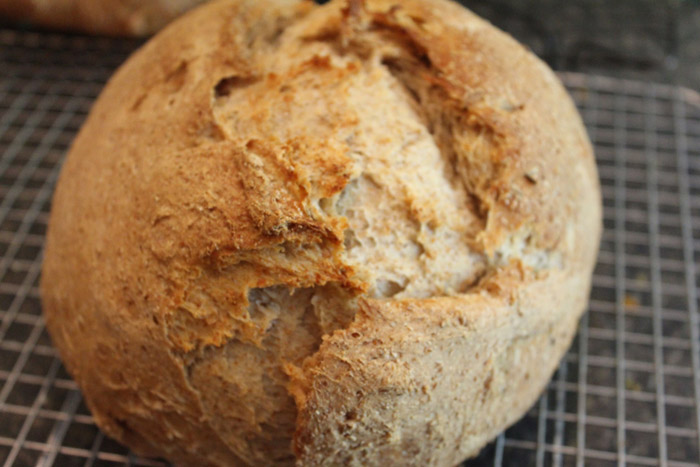You may notice a certain aroma when you drive past a grain field at this time of year. It’s the smell of grain ripening. The scent reminds me that it’s time to stock up on our families’ yearly supply of grain.
We started grinding grain into our own flour five years ago and never have looked back. Although making flour may not fit everyone’s lifestyle, if you are an avid bread baker, and are interested in maximizing health or economy of your household’s grain intake, getting started with milling your own flour may be a perfect fit for you.
Benefits of home-ground flour
First off, home-ground flour, consumed shortly after grinding, has a much higher nutrient content than store-bought flour which has usually been ground an unspecified time ago. Vitamins and other nutrients in the grain begin to break down as soon as the kernel is broken. True, often synthetic vitamins are added to store-bought flours, but if you’re like me, you much prefer the real thing. Because of this, home-ground flours boast much better flavour and quality than store-bought counterparts.
On a budget, home-ground flour also shines. With grain having a shelf life of up to 10 years, even if you do not consume a whole lot of bread, buying bulk grains will save you money in the long run.
Another attractive reason to switch to home-ground is the wide variety of grains and options that can be explored. This may be especially beneficial for those who follow a gluten free diet, or those who may be sensitive to glyphosate and prefer organic grains. I love to experiment with a wide variety of grains in my baking, such as spelt, red fife, buckwheat and einkorn.
How to get started
Up front, you may need to invest in a home flour mill. For smaller amounts, a good quality coffee grinder can work, or even a high-powered blender, like Vitamix or Blendtec, may help you get started. But if you bake a lot, a dedicated mill becomes invaluable. (Many grain mills can also grind legumes, and even oily seeds and nuts.) Mills can be manual or electric and range in price from around $200 to $1500. My mill was manual and when I realized that I didn’t want to spend hours cranking out flour before making a large batch of bread, my husband customized it with a motor which made the process much more efficient. (Some mills come with both manual and electric options.) Prairie Foods in Plum Coulee has a large selection of grain mills to choose from, as well as bulk whole grains. You can find a great video comparing several grain grinders at youtube.com.
Grain can be purchased in bulk from a variety of places. DeRuyck’s Top of the Hill Farm supplies many stores in southern Manitoba and makes monthly deliveries to Can-Am Country Corner. Stop in to see what Can-Am Corner has in stock, or order ahead of time to choose from the full range of organic grains and package sizes. Buying directly from a farmer is also an option. As many farmers don’t usually sell direct to the public, make sure to bring your own bags or containers and buy in bulk to make it worthwhile for both parties. This year we had an excellent rye crop, and if you would like to purchase rye grain, you can find our contact information on our website. (www.farmgreenpastures.com)
Home-ground flour should be used within a day of milling. If you will not be using it immediately, store it in the refrigerator or freezer to ensure the vitamins and minerals stay as intact as possible and prevent rancidity.
And of course, remember to store your whole grains in a dry and cool location to maximize the storage potential.
Grinding your own flour is a fun and interesting adventure that’s well worth the extra effort. To learn more, check out the many online resources on this topic or simply talk to your neighbor! You many be surprised how many people have experience with grinding their own grain.




